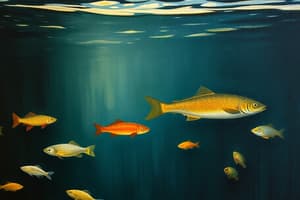Podcast
Questions and Answers
What do all organisms need to survive?
What do all organisms need to survive?
Energy
Where do plants get their energy from?
Where do plants get their energy from?
Sun
What is a food chain?
What is a food chain?
Sequence of who eats whom in a biological community
What is the primary energy source at the start of a food chain?
What is the primary energy source at the start of a food chain?
What defines a primary producer?
What defines a primary producer?
Who are primary consumers?
Who are primary consumers?
What are secondary consumers?
What are secondary consumers?
What do tertiary consumers eat?
What do tertiary consumers eat?
What do quaternary consumers eat?
What do quaternary consumers eat?
What does a food chain end with?
What does a food chain end with?
What travels through a food chain or web?
What travels through a food chain or web?
What is the ultimate energy source for all life on Earth?
What is the ultimate energy source for all life on Earth?
Describe the food chain from bottom to top.
Describe the food chain from bottom to top.
What are the two processes through which food is made?
What are the two processes through which food is made?
What do arrows represent in a food chain?
What do arrows represent in a food chain?
What happens to energy as it flows from organism to organism?
What happens to energy as it flows from organism to organism?
What is a food web?
What is a food web?
What is a trophic level?
What is a trophic level?
What are detrivores?
What are detrivores?
How does the position in a food chain vary?
How does the position in a food chain vary?
What is the 4th trophic level called?
What is the 4th trophic level called?
Why is energy lost when one organism eats another?
Why is energy lost when one organism eats another?
Are there more plants than plant-eaters?
Are there more plants than plant-eaters?
What happens when one species goes extinct?
What happens when one species goes extinct?
What occurs in a community's equilibrium?
What occurs in a community's equilibrium?
Study Notes
Energy in Ecosystems
- All organisms require energy to survive.
- Plants primarily obtain energy from the sun.
Food Chain Essentials
- A food chain illustrates the sequence of organisms that eat one another, essential for nutrition within an ecosystem.
- Begins with a primary energy source like the sun or deep sea vents.
Trophic Levels Overview
- Primary Producers: Autotrophs that create their own food through photosynthesis or chemosynthesis (e.g., plants, bacteria).
- Primary Consumers: Herbivores that feed on primary producers (e.g., rabbits eat grass).
- Secondary Consumers: Carnivores or omnivores that consume primary consumers (e.g., snakes eat rabbits).
- Tertiary Consumers: Predators that eat secondary consumers (e.g., owls eat snakes).
- Quaternary Consumers: Top predators with no natural enemies (e.g., hawks eat owls).
Energy Flow in Food Chains
- Energy flows from the primary energy source through various trophic levels, with approximately 10% of energy available to each succeeding level.
- Energy is lost at each trophic step, primarily as heat.
Food Webs and Interdependence
- A food web is a complex network of interrelated food chains, highlighting energy transfer and organism interactions.
- Organisms' positions in food chains can shift based on their dietary choices.
Decomposers and Energy Recycling
- Detrivores consume dead organisms (e.g., vultures, crabs), aiding in energy transfer.
- Decomposers like bacteria and fungi break down organic material, continuing energy flow within ecosystems.
Populations and Equilibrium
- Ecosystem stability can be disrupted by species extinction, resulting in unpredictable consequences.
- Carnivore and herbivore populations influence each other's stability, leading to a state of equilibrium.
General Principles
- There are more plants (autotrophs) than herbivores (heterotrophs) in an ecosystem.
- Energy dynamics and interdependence are key to maintaining ecological balance.
Studying That Suits You
Use AI to generate personalized quizzes and flashcards to suit your learning preferences.
Description
Explore the fundamental concepts of energy flow in ecosystems, focusing on trophic levels and the roles of different organisms. Understand how energy transfers between primary producers, consumers, and decomposers in food chains.




